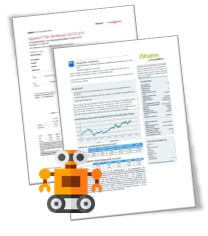The providers of robo advisors are increasingly targeting a younger clientele. Generation Y has far less wealth than baby boomers. Consequently, providers must lower the barriers to entry for robo advisors in order to convince younger customers of their offer. The article shows 3 reasons how robo advisors transfer the discount principle to the fund industry. Finally, I will give an outlook on the robo advisor market and present my 3 favorite providers.
Example: Quirion*: According to the provider, the average customer is currently around 50 years old. Just under eleven percent of customers were under 30 in the fall of 2019. Quirion made it easier for new investors and young professionals to build up assets by lowering its minimum investment amount to 1,000 euros. In addition, the provider completely eliminated the service fee for the first 10,000 euros invested. Low costs together with a low minimum investment of 1,000 euros are thus a real alternative even for investors just starting out in their careers. Especially in the ongoing low-interest environment, people with no stock market experience can protect their money with a robo advisor before the Inflation protect. By the way, quirion also offers savings plans for customers with installments starting at 30 euros per month.
Initially, lowering the minimum investment amount to EUR 1,000 was only intended as a test run. They wanted to see whether it was possible to convince a younger clientele of the Robo Advisors' offer. Since the offer was very well received, quirion decided to continue the test. As a result, customers can continue to benefit from a low minimum investment amount of EUR 1,000. However, there are 2 other reasons why the barriers to entry for robo advisors will continue to drop in the future.
Furthermore, the fund costs are likely to continue to fall in the future. At least the trend towards lower fees is continuing for ETFs. The second largest asset manager provider worldwide - Vanguard - has been continuously reducing costs for many years. At the end of 2019, Vanguard reduced fees on 13 ETFs and 18 index funds. Since then, ETFs have been managed with fees of just 0.12 percent, while index funds are still a slim 0.16 percent.
The discount principle is a recipe for success in the fund business. Through consistent cost reductions, the market is developing from a niche market to a mass market. The market fueled in this way now makes fund managers of active funds look old. In contrast to passive funds, active funds charge between 1-2 % annually in fees. ETFs can easily undercut this, as shown by the example of Vanguard. In the graphic, the costs of investing are shown as an example based on knowledge and effort.
The barriers to entry for robo advisors continue to fall. If robo advisors have already left active funds far behind, it can be assumed that the costs will hardly differ from the costs of an ETF portfolio in the future. at Quirion* this is already the case for the first 10,000 euros. I have referred to providers such as Quirion as discount robo advisors in the graphic. They are on par with ETFs in terms of costs, but offer a significantly better service.

In addition to the reasons already mentioned, that both robo advisors and fund providers are constantly turning the screw on costs, there is a third reason for the drop in prices for robo advisors. Since the end of 2019, Deutsche Börse has no longer charged transaction fees in its Xetra trading system for robo orders or ETF savings plans. The aim of this campaign is to make these forms of investment more attractive.
These were 3 reasons that show why there will be further cost reductions for robo advisors in the future. As a result, barriers to entry for robo advisors will continue to fall in the future.
In the following I give an outlook on the robo advisor market and present my 3 favorite providers. These are already convincing with low entry hurdles and are therefore also worth a look for young investors, such as those starting their careers.
Outlook on the market for digital investment aids
In the persistently low interest rate environment of the last ten years, robo advisors have quickly attracted attention since their German launch in 2013. Large investment funds now rely on software-supported investment by robo advisors. The advantages of the digital business model are obvious: a large part of the costs can be eliminated, as can the subjective decisions of the previous business. Due to the large number of providers and the still young market, a consolidation of the providers can be expected in the next few years. It can therefore be assumed that the number of robo advisors will shrink sharply. Although robo advisors have been a success model in recent years, they have yet to prove themselves in a bear market and the associated withdrawal of investment funds.
Robo advisors are managing more and more client funds
The competition will watch with interest as they develop Quirion*, which regularly achieves good test results from consumer advocates. In 2019, the total amount invested by investors via robo advisors was around 7,500 million euros. In 2020, Statista forecasts a further increase in funds under management by around 65 % to over 12,300 million euros. The provider Quirion was able to more than double its number of users in 2018. After the start of the reduction in the minimum investment amount, the provider was able to record another strong increase in customers within a few weeks.
Since the market for robo advisors is now highly competitive with over 30 providers, there will be further lowering of the entry hurdles in the future. This is viewed as desired by consumer advocates. For the robo advisors, it is apparently currently the only possible way not to be pushed out of the market.
Recommended providers with low barriers to entry
The principles of a long-term successful investment are an asset allocation according to your risk profile and low annual costs. Contrary to what is often claimed and assumed, these are the main factors of a long-term successful investment. In the robo advisor comparison, these principles are followed by the cheap robo advisors Growney, Quirion and world invest very well implemented. If you choose one of the providers, the next step is to consistently stick to the strategy. This is how you remain successful in the long term.
at Quirion* you can invest in ETFs from a monthly savings rate of 30 euros. In addition Quirion* test winner at Stiftung Warentest in August. An easy-to-use and cheap robo advisor with sufficient risk classes is also offered by Growney* offered. A test report Growney* do you think ...? Find here. If you already have more concrete ideas about your investment, the provider world invest* Worth a look.
Quirion: Robo-Advisor with a passive investment approach
- Savings plans from 30 euros per quarter
- Test winner at Stiftung Warentest.
- Best quality judgment at the lowest costs.
- Promotion: Invest up to €10,000 free of charge.
- Focus on industrialized countries
- Promotion for new customers until January 31, 2020: 30 € savings rate for free
Growney: Robo advisor with a passive investment approach
- Simple opening with a simple questionnaire with 10 questions (see Review)
- Focus on industrialized countries and emerging markets
- According to €uro am Sonntag Best Robo Advisor 2019
- 5 Return, risk and tax-optimized ETF portfolios
- No minimum investment amount, no notice periods
Weltinvest: Supporting robo advisor for self-deciders
- Very low cost from only 0.49 % pa
- Low minimum investment starting at 500 euros
- Savings plan from 50 euros
- World Saving uses Vanguard ETFs.
- Due to the cooperative structure of the Vanguard Group, investor interests are always the focus
The recommendations are all implemented and cost-optimized through passive ETF portfolios. As a result, you cost the investor less than 1 percent in fees annually. Furthermore, the recommended providers take care of the technical implementation of the strategy.
>> Why I and numerous scientists believe the passive approach is the right one <<
Barriers to entry with robo advisors are falling: conclusion
This article shows 3 reasons how robo advisors transfer the discount principle to the fund industry. First and foremost, you turn the cost screw yourself and lower the entry hurdle in the form of the minimum investment amount. This was shown using the example of the provider Quirion. Second, ETF fees have been in a downward spiral for many years. Thirdly, Deutsche Börse has also released fees for trading via XETRA ETFs and Robo Advisors.
It can be assumed that the price spiral will continue to spiral downwards and that there will therefore be a sharp increase in the funds managed by robo advisors. At the same time, the number of providers will be reduced so that economies of scale can be better exploited. With these 3 measures, robo advisors, the ETF providers and XETRA lower the barriers to entry for robo advisors. For more information on the subject of robo advisors, I recommend one provider comparison and reading through my advice article for further knowledge building.
My recommendation for a robo advisor is Quirion* With Quirion you can invest in ETFs from a monthly savings rate of 30 euros. In addition Quirion* test winner at Stiftung Warentest in August. An easy-to-use and cheap robo advisor with sufficient risk classes is also offered by Growney* offered. A test report Growney* do you think ...? Find here. If there are already more concrete ideas about the investment, the provider world invest* Worth a look.
_____
*Affiliate link: If you use one of these links to go from my website to a provider, I may receive a commission. There are no additional costs for you. For using these links a ❤️ THANK YOU! ❤️
Disclaimer: This is well researched but non-binding information.






